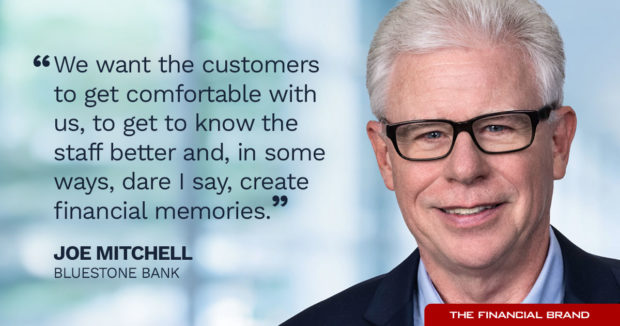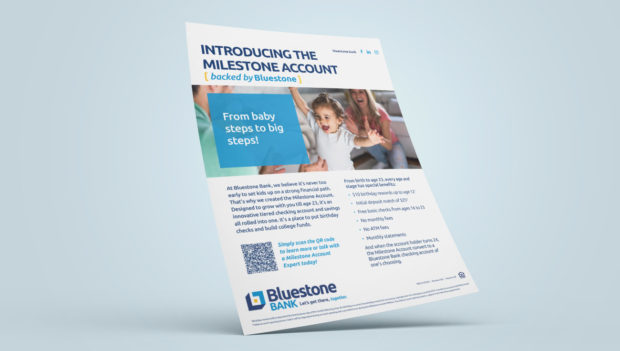Bluestone Bank was ready to freshen up its checking account for teenagers and develop a product for even younger children this past summer. But the bank didn’t want to mimic what its competitors were offering.
“We knew we could do a better job than we were doing,” says Joe Mitchell, first senior vice president and retail banking officer at the Raynham, Mass., bank.
Bluestone went on to develop what it calls the Milestone account, a savings and checking product that evolves over time. The account gives children greater control and more options, such as access to Zelle, as they get older. Other sweeteners include a $25 account-opening bonus and a 5% interest rate on the first $500 in savings. The rate drops to 0.01% on balances above that.
The accounts, available to customers from birth through the age of 23, aren’t designed to rake in deposits, however. They are intended to help Bluestone connect with young people, the ones who are most tempted by the ever-expanding range of digital banking competitors.
“We want the customers to get comfortable with us, to get to know the staff better and, in some ways, dare I say, create financial memories,” says Mitchell.

Instant Messaging. Instant Impact.
Connect with your customers and provide lightning-fast support as effortlessly as texting friends. Two-way SMS text messaging is no longer optional.

Move the Needle from Attrition to Acquisition
Vericast’s 2024 Financial TrendWatch explores seven of today’s most critical financial services trends to provide a complete view of the current loyalty landscape.
Read More about Move the Needle from Attrition to Acquisition
Giving Young People an Alternative to Fintechs
Over the last 15 years, with interest rates near zero, traditional banking accounts have offered little satisfaction — let alone memorable moments — to young savers, says Lawrence Glazer, chair of the nonprofit Massachusetts Jump$tart Coalition for Personal Financial Literacy. Now, with interest rates rising, banks and credit unions have a fresh opportunity to engage with young people, he says.
At the same time, financial institutions face a bevy of high-tech competitors and a generation used to seeing numbers pixelated on a screen instead of penciled into a check ledger. People ages 18 to 24, an age range that makes them members of Gen Z, are 200% more likely than the average consumer to use fintech solutions such as digital payment platforms, mobile investment apps and mobile wallets, according to AnalyticsIQ, a marketing data and analytics company in Atlanta.
The digital trends are likely to accelerate with those under age 18, says Jim Perry, a senior strategist at the consulting firm Market Insights. “If you are not competing in the digital space right now, you might as well say goodbye to them because they already have five different financial apps on their phones and they’ve had them there since they were 12.”
But while the tools may be different, the financial skills and habits young people need haven’t changed much — and that gives traditional financial institutions an opening, says Chris Caltabiano, chief program officer at the Council for Economic Education in New York City.
“I often hear we don’t need to teach kids about checking because no one writes checks,” Caltabiano says. “That is right. But kids still need an understanding of how money goes in and out and how to keep track of it.”
Banks and credit unions can help young people begin to understand the ins and outs of their financial life, and eventually offer tools to help them manage it, Caltabiano says. “That’s where the product comes into play.”
Research suggests young adults, at least, are in need of guidance. According to AnalyticsIQ, members of Gen Z are less likely than other adults to be financially organized and to make financial plans. (Gen Z consists of those born between 1997 and 2012. Gen Alpha follows starting in 2013, per our guide to the generations.)
Creative and Unique: Perfect for Word-of-Mouth Marketing
Bluestone Bank’s Milestone account is a creative approach, particularly given the interest rate it promises, says Glazer, who is also managing partner of Mayflower Advisors, an independent investment advisory in Boston.
“The best way to teach compound interest is to actually have a bank account that pays interest,” he says. “I think this is a good step and hopefully it’ll be something that other financial institutions embrace.”
Bluestone, which has assets of about $1.4 billion, introduced the Milestone account in August 2022. The bank promoted it through digital ads, search campaigns, email blasts, social media and even flyers stuffed into drive-through tubes by tellers who noticed children in a car.
The vast majority of new accounts, however, have come through word of mouth and staff interactions with customers, says Mitchell. “That would be something I consider a strength of our team here at Bluestone: reaching out to customers. They make a lot of phone calls for a lot of different reasons. Having something to offer or sell that’s a little unique or compelling is something they like to do.”
Beyond the initial hooks of the account-opening bonus and high interest rate, many of the other features change across four phases as account holders age, from birth to 12 (First Steps), 13 to 15 (Keeping Pace), 16 to 18 (Gaining Ground) and then 19 to 23 (Building Up).
Birthdays prompt a $10 bonus up to age 12, for example. Mobile banking and debit cards are available starting at age 13. Once account holders turn 18, they have access to Zelle. And at 19, they have the option of kicking their parents off the account.
Debit transactions, meanwhile, are limited to $250 per day for those between 13 and 15. The cap jumps to $1,000 per day for those between 16 and 23.
Bluestone worked with Pannos Marketing in Manchester, N.H., to develop its campaign for the Milestone account.
Read More:
- Is Gen Z the Answer to Banking’s Struggle with Acquiring New Accountholders?
- Gen Z Takes Money Seriously — and Will Leave Banks that Don’t Deliver
- Enthusiasm for Apple Savings Account High Among Gen Z

Bluestone Bank’s Relationship-Building Strategy
The previous teen account at Bluestone was primarily focused on providing debit cards to those between 16 and 18, Mitchell says. Competitors were offering similar products for children even younger.
Bluestone could have done the same, and parents might have been content ensuring their tweens had debit cards, too. But the bank wanted something that created opportunities to engage with young customers about finance, a feature that also might appeal to parents, Mitchell says.
The changing parameters of the Milestone account give Bluestone an opportunity to build relationships. The bank sends a letter to customers when they move to the next stage and follows up with a phone call, Mitchell says. “We think that really, really makes a big difference.”
Reaching young people by phone hasn’t been easy, though. They prefer texting. “And that’s a challenge we haven’t been able to master,” says Mitchell, citing the confidentiality issues faced by financial institutions trying to text.
When Bluestone does get through, staff members discuss how the account is changing and share advice on how to take advantage of it. “We can actually educate you on how these things work, what to do, what to avoid for a variety of reasons,” says Mitchell, noting that young people are just as susceptible to fraud as other customers.

How Banks Are Fortifying Their Data Against Increasing Cyber Threats
This webinar from Veeam will detail the value of working together across your organization to be better prepared in cyber defense and response readiness.
Read More about How Banks Are Fortifying Their Data Against Increasing Cyber Threats

Unlocking Digital Acquisition: A Bank’s Journey to Become Digital-First
This webinar will offer a comprehensive roadmap for digital marketing success, from building foundational capabilities and structures and forging strategic partnerships, to assembling the right team.
Read More about Unlocking Digital Acquisition: A Bank’s Journey to Become Digital-First
Milestone Account: From Birth Through College
Mitchell declined to say how many accounts had been opened but offered a breakdown by phase. Roughly a third of Milestone account holders, or 33%, are in First Steps; 17% are in Keeping Pace; 35% are in Gaining Ground; and 14% are in the last phase, Building Up.
Parents can open an account for children from birth on, as long as they have a social security number. When the account holder turns 24, they can opt to move into whichever Bluestone checking account they prefer.
Despite the intensifying competition on the digital front, Mitchell says he is confident Bluestone can retain its young Milestone account holders as they age and their needs evolve. He notes that when he talks to students at a local college as part of their coursework, most say that they still bank where their parents took them.
“If we are doing our job — building relationships, providing the proper service — we should be able to hang on to them,” he says.









